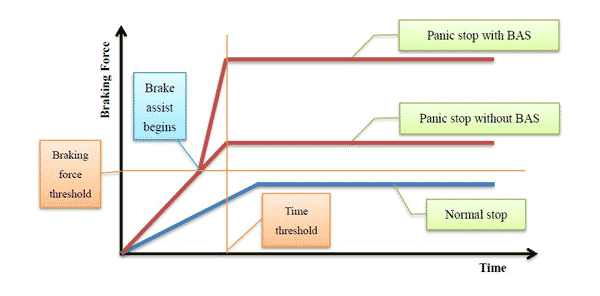When an emergency happens, the reaction time is so short before the driver hits the brakes that not enough pressure may be applied (As the figure in left shows). As a result, the car may not stop in time. But in a car equipped with BAS, even if a driver fails to apply enough pressure to the brake, the Brake Assist sensors will detect the driver's sudden or "panic" braking and exert additional pressure (As the figure in right shows). This additional pressure can help the car avoid hitting the obstacle.

The pedal which color is light green shows the ideal position the brake pedal should be to exert enough braking force. The pedal in gray color shows the actual situation, the brake pedal isn't pressed deep enough because of the short reaction time.
The brake assist system functions only during emergency braking. In such situations, the systems computer analyzes whether or not to activate brake assist, based on how fast and hard the brake pedal is pressed. When the speed with which the brake pedal is depressed is higher than the threshold, the computer knows that there is an emergency and a larger even full braking force should be applied. Some advanced brake assist system also take into account the speed with which the throttle pedal is released and pre-tensioning the brakes when a panic release of the throttle pedal is detected. In emergency situation, the maximum brake force will be developed within several milliseconds, and this speed is much faster than that of a driver pressing a pedal. In this way, brake assist can reduce stopping distance by a significant margin, up to 45% in some studies, and help to prevent accidents, especially rear-end collisions.

A more advanced brake assist is called a driver-adaptive system. In other words, this system can measure and monitor the driver's application of the brakes and throttle. Thus, this kind of brake assist system can actually tell the difference between slowing down at a traffic light and making a panic stop when emergency happens based on the driving patterns of the driver, avoid exerting full braking force when it is unnecessary.

